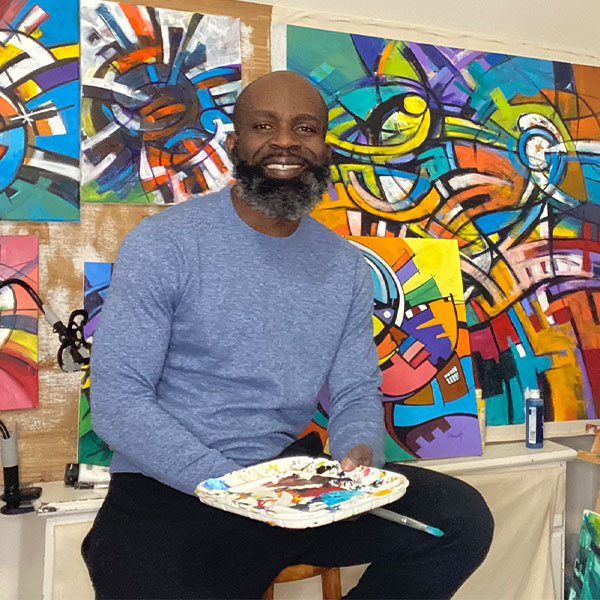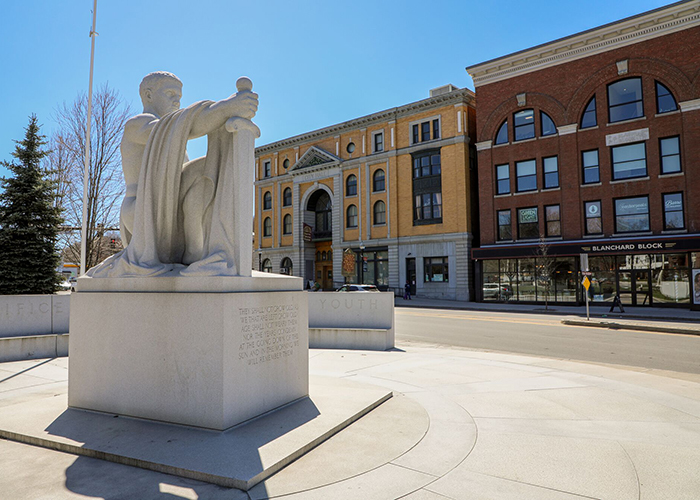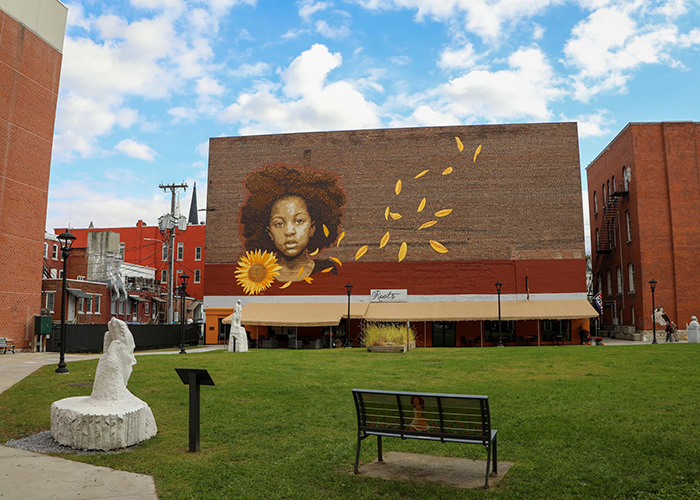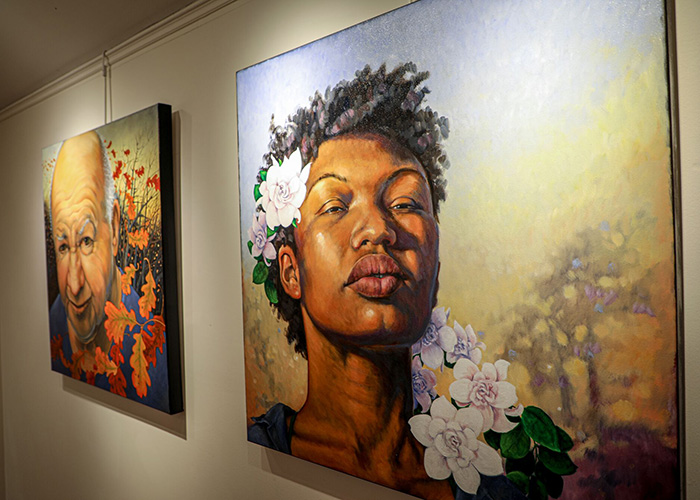Burlingtonian artist Julio Desmont’s abstract paintings burst with color, movement and bold geometry, and often bird-like figures. Born in Haiti in the town of Camp-Perrin, Julio grew up drawing inspiration from the vibrant natural world around him and from tap-taps, the brightly decorated pickup trucks and buses used as share taxis around the island. His paintings evoke both these early inspirations and later influences such as Picasso, Georgia O’Keefe, Basquiat, and Kandinsky.
Community is as important to Julio’s work as inspiration. Since moving to Vermont in 2018, he has worked with the Clemmons Family Farm as a teaching artist, offering painting workshops for the community and developing curricula with local school districts. Julio is on the core teaching artist team for the Farm’s Windows to a Multicultural World K-12 curriculum of African American and African diaspora history, art, and culture education. In 2021, Julio founded the nonprofit Draw 1 Inc. to provide arts education to children in need in Haiti.
Julio shared his thoughts on being a Vermont artist.
How has living as an artist in Vermont affected your creative process?
The landscape of Vermont reminds me of a more organized and beautiful place like home. The open fields, the woods… I can stand from anywhere and see the horizon. Lake Champlain still reminds me of the crystal, sandy, blue beaches back home. The vibrant display of colorful skies on a clear day sitting in Battery Park. My mind is free from high-rises and corridors, and the overwhelming noise of rush hours, the sirens… Though I love the big cities, nothing compares to Vermont, its openness. The possibility to create space has been influential to my work. Being part of a community, and living a life of purpose play a great part in my creative process.
What is something about your art that has changed over time?
You’ll see I intend to show birds in my paintings if you look closely. Silhouettes of white birds, which I have thought of as a sign of wisdom, purity, greatness, holiness… I think over time I am embracing how to incorporate black birds into my art, too.
I’ve had one of my most eye-opening experiences with seagulls on North Beach in Burlington. It was a beautiful Sunday in summer 2015. I was relaxing with my brother and two other friends. I saw some white and grey birds trying to go through unattended beachgoers’ belongings, looking for food. Once they found something, they made that sharp, alarming sound, and all the flock came and enjoyed whatever was there to eat. People weren’t too nice to them. Nobody threw food at them, and they wanted food. So I pulled out a bag of chips and started feeding them. That was so intense. Their sound gets right into my heart. I felt so happy and united with nature. Later on when I got home, a friend called to check on my visit. I told him I was at the beach feeding birds. He was like “Birds?” I said yes, and he was like, “No, you didn’t do that.” I said why not?
He explained that if you feed those birds, they’re going to fly over the people’s heads and drop their waste. My happiness now turned into worry. I reflected, no wonder why people were looking at me in disdain.
If it had been a black bird, my reaction would have been different. I would definitely have chased them away and made sure they didn’t get near me at all. A black bird scares me because it bears the curse of death, the devil, evil spirits, negativity… All that I learned growing up as a Baptist Christian.
That experience changed my perception about the symbol of birds and their color. I am starting to look at crows and ravens.
What is your vision for the next several years?
For the next several years I want to establish myself as an emerging and full-time artist. I plan to expand Draw 1, a nonprofit organization with the mission to provide access to art and education directly to one needy Haitian child at a time, fostering hope and preparing them for making better choices. We are still tiny, only a year old. The idea for Draw 1 came to me after I was thinking about solutions to the poverty in Haiti, as all I could learn of were the problems.
Visit Julio’s website.
Listen to this interview with Julio and fellow Clemmons Family Farm artists.
The I am a Vermont Artist series explores how artists’ creative expressions reflect their experiences of ethnicity, gender identity, religion, disability, or age. Covering all artistic disciplines, and a range of backgrounds—from New Americans to the state’s first residents—we hope to amplify voices that deepen our understanding of what it means to be a Vermont artist.






